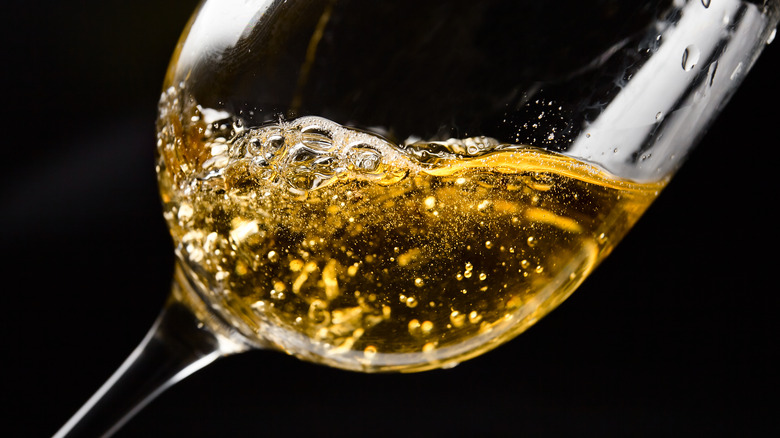Why You Should Never Put Ice In Dessert Wine, According To A Sommelier
Whether you're sharing a celebratory toast or relaxing in the warm afterglow of a great meal, you may want to sip on a boozy beverage. Dessert wines pair well with sweet treats and are a great choice to imbibe alongside a post-dinner confection. Like other wines, dessert varieties are best enjoyed slightly chilled and are usually served in a small glass.
If you're running behind and forgot to chill your wine, it can be tempting to drop an ice cube or two into your glass to cool the liquid quickly. According to sommelier Doreen Winkler, this simple hack is actually a huge mistake. Winkler — who recently curated the wine list at Manhattan's Japanese restaurant, Mishik – has over a decade of rich experience in the wine industry. From hotels in Germany to Michelin-starred enterprises in New York, she's built several successful wine programs and was recognized by Forbes as one of America's Top Sommeliers in 2016. When it comes to adding ice to dessert wine, Winkler feels that it can ruin the wine's texture and should definitely be avoided.
The proper way to serve dessert wine
One of the important qualities of wine is its texture, or how it feels inside your mouth. Texture adds to the depth and complexity of wine and is an essential distinguishing factor for any bottle. Dessert wines are generally known and appreciated for their thick, syrupy texture. While it might seem innocuous, adding ice to a glass of dessert wine might rob it of any special texture it possesses. In an interview with the Daily Meal, Winkler shared her firm thoughts on ice: "Never put that ice cube into a dessert wine," she says. Otherwise, "Its entire texture will be ruined!"
Just because adding ice to a wine is a bad idea doesn't mean it shouldn't be colder than room temperature. While Winkler thinks it's a good idea to "lightly chill" all wines, she recommends a specific range for most dessert wines. "Sauternes, Beaume de Venise, Moscato di Asti, and others," she says, "should be served chilled between 45-60 Fahrenheit." Winkler notes that fortified dessert wines — which include an added distilled spirit like brandy — can be served in a higher temperature range, from 60 to 65 degrees Fahrenheit.
If you're in a pinch and need to chill your wine without watering it down, place the wine bottle in a bucket filled with ice and salt. Covering most of the bottle in ice will ensure a quick cooling time, and the salt will facilitate a faster drop in temperature.
What makes a dessert wine?
Dessert wines are distinguished by higher levels of sugar compared to those found in regular wine. To increase the sugar content, growers leave grapes on the vine and allow them to ripen further before harvest. If perfect conditions align, farmers will sometimes allow the Botrytis cinerea fungus to form on vines; this beneficial growth — known as "noble rot" — leads to gross-looking brown, shriveled grapes but creates an exceptionally sweet juice prized as an ingredient for top-shelf wines.
Most distinguished winemaking regions offer their own take on a dessert wine. Sauternes is made near Bordeaux in France and commonly utilizes the noble rot fungus. Moscato di Asti is produced in Italy and offers a semi-sparkling finish. Riesling is made in Germany and is known for its fruity flavor and bubbles. Famous fortified dessert wines include Sherry, which is produced in Spain, and Madiera, which is grown on an island of the same name off the coast of Portugal. Port, also from Portugal, incorporates both red and white grapes into its famous aged bottles.


